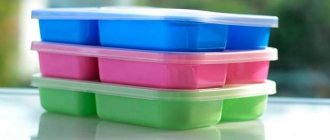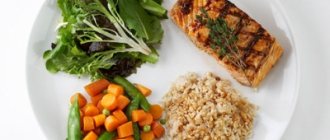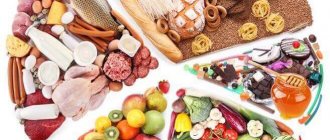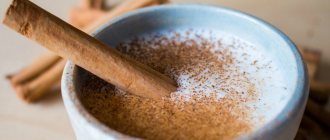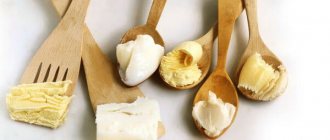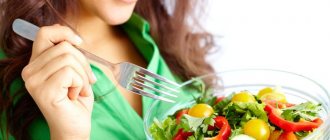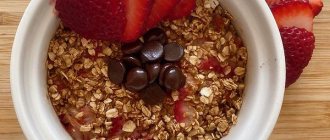Healthy nutrition is one of the main components of health. This becomes especially important during adolescence. After all, it is then that the child’s second growth spurt occurs—the moment when his growth sharply accelerates. During this period, the body needs a maximum of nutrients and vitamins. And given how behavior changes during puberty, and how difficult it is to get a teenager to eat healthy food, the issue of healthy and tasty nutrition becomes of paramount importance. Let's figure out how to create a complete menu for a teenager.
Essential Nutrients
To ensure proper nutrition for teenagers, you need to adhere to a number of rules and principles. One of the basic rules is the correct ratio of essential nutrients, or nutrients: proteins, fats and carbohydrates. After all, about 40% of the human body consists of these substances, while the remaining 60% is water. The optimal ratio of these nutrients to ensure normal growth and development of a teenager’s body is: 1 part protein, 3 parts fat and 5 parts carbohydrates.
Eating disorders in adolescents
Let's talk separately about cases of eating disorders in teenagers. The recommendations given in this material may harm a teenager at risk of developing eating disorders (although choosing food together or shopping or cooking is still rather good advice).
Lecture on eating disorders in adolescents video
If you suspect that your child has an eating disorder, you should definitely contact psychologists/therapists for additional help. One of the symptoms of an eating disorder is when a person feels anxious, guilty, or sad about eating.
Seek help, as teenagers are the most vulnerable category for this spectrum of disorders, and not only girls, but also boys.
We will be happy to answer all your questions, sign up for a psychological consultation and tell you the details!
Our phone number has not changed:
The importance of proteins
Since school, we have heard more than once that proteins are the main building material of the body. However, what does this phrase mean?
First, almost every substance inside our body is made of protein. Hormones are proteins, blood clotting factors, thanks to which we do not bleed at the slightest injury - also proteins, RNA and DNA, which contain hereditary information - again protein, hemoglobin, which transports oxygen to cells and tissues, also has a protein structure.
Secondly, proteins are made up of amino acids, eight of which are essential. That is why they are called “essential”, since they can only be obtained from the outside, with food. They cannot be synthesized in the body by themselves. And amino acids are not only the “building blocks” of our body, but also the most important component of water exchange between cells and tissues. By creating pressure in the blood vessels, which is called oncotic, proteins prevent the flow of water from the blood into the cells, preventing their swelling and death.
Thus, the presence of protein in the diet is extremely important.
Meaning of carbohydrates

And if proteins are the “building blocks” of the body, then carbohydrates are the main source of energy. Being in products in the form of polysaccharides, in the gastrointestinal tract they break down to di- and monosaccharides (glucose, fructose, galactose).
The importance of carbohydrates is truly enormous, since if they are insufficient in the body, fats, and then proteins, begin to be used for energy. Reasonable limitation of simple carbohydrates (flour products, sweets, etc.) can really be useful, because excess fat will be lost to obtain energy, which will lead to weight loss. But a complete refusal of carbohydrates, including complex ones found in vegetables and fruits, leads to anorexia, a deterioration in general condition, and a change in blood pH to a more acidic side (acidosis).
This can indeed be very dangerous, especially for teenage girls who so want to be “perfect.”
GBU RO "MEDICAL INFORMATION AND ANALYTICAL CENTER"
RATIONAL NUTRITION IS THE KEY TO HEALTH
(memo for teenagers)
Proper nutrition during adolescence (from 10 to 18 years) plays an important role in the formation of a maturing body. During this period, significant changes occur in the body’s response to various environmental factors, puberty occurs, in the period from 10 to 13 years, accelerated growth of the body is observed, from 13 to 16 years, the active formation of endocrine glands is observed, and a number of parts of the brain are formed. According to statistics, about 30% of chronic diseases in adolescents studying in general education institutions are associated with poor nutrition.
The most important principle of rational nutrition for adolescents is ensuring that the caloric content of the diet matches the energy expenditure of the body.
Food is a “building material” necessary for the growth and development of the body. The heat and energy consumption of a teenager is relatively higher than that of an adult. So, an adult needs an average of 40–42 kcal per day, a teenager – 50–52 kcal per 1 kg of body weight. Teenagers should receive at least 2900 - 3100 kcal per day, with the daily caloric intake distributed among meals as follows: breakfast - 25%, lunch - 35 - 40%, afternoon snack - 10 - 20%, dinner - 20 - 25% . It is useful to give a teenager vinaigrette, radishes, radishes with sour cream or vegetable oil, tomatoes, fresh cucumber, green onions with sour cream or herring before meals. Vegetables stimulate the appetite, promote the secretion of digestive juices and improve digestion.
- Insufficient calorie intake leads to rapid depletion and disruption of the functions of all organs and systems.
The diet of adolescents should be balanced in terms of the content of essential nutrients: proteins, fats, carbohydrates, vitamins and minerals.
A teenager's diet should be varied and include products of animal and plant origin. Proteins - the main component of any living cell - are used to build tissues and organs of the body: muscles, nerves, blood, brain, heart, etc. During the period of active growth, an increased amount of calcium is required, which is necessary for the prevention of diseases of the musculoskeletal system, so it is necessary to include dairy products in the diet of adolescents - cottage cheese, milk, kefirs and yoghurts. In addition, the most important building material is animal protein contained in meat. The optimal ratio of proteins, fats and carbohydrates can be expressed as 1:1:4, i.e. a teenager should receive 4 times more carbohydrates than proteins and fats. They are especially important for the formation of the body's defenses - the so-called immune bodies. Under the influence of digestive juices in the gastrointestinal tract, proteins are broken down into simpler substances - amino acids. In cells and tissues, new proteins necessary for a given organism are formed from amino acids. The daily protein requirement for a teenager is 1g. for 1 kg. normal body weight. Fats and carbohydrates are the main sources of energy. Their amount in a teenager’s diet is reflected in his body weight. The most valuable dairy fats for teenagers are: butter, cream, sour cream. They are well absorbed and are a source of vitamins A and D. The daily diet should also include 10–20 g of vegetable oil, which contains fatty acids that are important for a fast-growing body. To prevent acne, it is recommended to limit your intake of foods high in fat. Carbohydrates are found mainly in products of plant origin - sugar, bread, cereals, potatoes, vegetables, fruits, berries. With proper nutrition, a teenager should receive about 500 g of carbohydrates during the day.
- An unbalanced diet can lead to obesity and developmental delays, diabetes mellitus and hypertension.
A significant portion of the minerals obtained from food is used for bone growth and teeth formation. The richest sources of calcium and phosphorus are milk, dairy products (especially cottage cheese, cheese) and vegetables. It is useful to prepare cheesecakes, dumplings, porridge with milk, milk soups for teenagers, and be sure to give vegetable side dishes for meat and fish dishes. This will allow you to regulate the correct ratio of calcium and phosphorus. When combining products of plant and animal origin (for example, milk with cereals), calcium absorption increases significantly. Phosphorus salts enter the body from products of animal and plant origin (liver, brains, cheese, fish, beans, nuts, cereals, etc.). They have a beneficial effect on the central nervous system, especially during periods of intense mental work.
- A lack of calcium and phosphorus salts in the diet leads to improper development of bones, damage to teeth and disruption of the central nervous system.
Food should also contain salts of iron, iodine, potassium, magnesium, sodium, sulfur, manganese, etc. Thus, iron is part of blood hemoglobin, sulfur is part of amino acids (cystine), iodine is part of thyroid hormone. The vast majority of minerals contained in the body are found in the bones. Table salt adds flavor to food and is also used by the body to produce hydrochloric acid, which is part of the gastric juice and plays a large role in the digestion of food. Food must contain very important organic substances - vitamins. They promote chemical transformations of basic foodstuffs and promote normal growth and development of the body. Vitamin A is found in milk fats, butter, egg yolk, milk, fish oil, liver, carrots, tomatoes, pumpkin, apricots, persimmons, lettuce, spinach, rose hips, and yellow corn. Vitamin B 2 (riboflavin) increases the digestibility of food, is involved in metabolism and hematopoiesis, and affects the growth of a teenager. Vitamin B2 is found in milk and dairy products (cottage cheese, cheese), eggs, yeast. Vitamin C is found mainly in fresh vegetables, berries and fruits (onions, black currants, rose hips, lemon, orange, lettuce, tomatoes, cabbage). A varied diet satisfies the body's daily need for vitamins and minerals. Vitamin D is found in egg yolk, caviar, milk, butter and especially fish oil.
- Deficiency of micronutrients - vitamins, microelements, polyunsaturated fatty acids leads to the development of immunodeficiency states.
Organizing a balanced diet requires adherence to a daily routine - a clear meal schedule.
For normal growth and development, adolescents need a correct diet, which includes strict adherence to meal times, rational distribution of food by weight, calorie content and volume, i.e. Teenagers' meals should be fractional, regular and even. Eating at the same hours maintains a good appetite and promotes the timely release of gastric juice. A teenager should eat at least 4 times a day, i.e. every 3 – 4 hours.
- Long breaks between meals adversely affect the digestive function of the body and can cause fatigue, decreased performance, headaches, and the formation of functional abnormalities and diseases.
Sample menu for teenagers
Ideally, the ratio of meals should be as follows: breakfast - 25%, lunch - 35-40%, afternoon snack - 15% and dinner - 20-25% of the total daily food volume.
For breakfast you should eat hot meat dishes and snacks. For example, a vegetable or fruit salad, a sandwich with butter and cheese. You can wash it down with hot tea, cocoa drink, jelly, rosehip infusion or compote. Coffee is especially contraindicated for teenagers in the morning. Ideally, this is porridge with milk, stewed meat or fish, or casserole, or vegetable stews.
At lunch it is simply vital to have a first course, soup, chicken broth and so on. The second one is definitely hot. Meat or fish with a side dish of vegetables or cereals. It is also good to eat fresh fruit at lunch. You should not overuse cereals; this dish is enough once a day. But it is advisable to use different cereals in porridges. Buckwheat, oatmeal and millet cereals must be present in the diet.
Teenagers' meals do not necessarily include an afternoon snack. Firstly, it will replace unwanted snacks, and secondly, it will bring a lot of benefits to a growing body. Just as it should consist of dairy and bakery products.
Dinner should be light so as not to overload your stomach at night. It could be a casserole, a light porridge, an omelet. And just before bed, it’s very good to drink a glass of non-cold milk, preferably with honey.
Product groups
There are six groups of products that are simply vital for the full growth and development of a teenager.
1. Complex carbohydrates. These are the main suppliers of energy, which is so necessary for rapid growth. They are found in cereals and cereals.
2. Products containing protein. This includes animal meat, poultry and fish. Protein is the main building material for soft tissues and internal organs. And, by the way, meat, especially red meat, contains iron, a deficiency of which can cause anemia in a teenager.
3. Plant fiber. They are nothing more than vegetables, roots and fruits. Fiber is necessary for normalizing the gastrointestinal tract and cleansing the body of toxins thanks to the natural antioxidants contained in these products.
4. Vegetable fats. These are vegetable oils and various nuts. The use of these products can greatly help a teenager avoid problems with hair loss and brittle nails that are quite common at this age.
5. Milk and fermented milk products. These are essential suppliers of calcium, vitamin D and phosphorus in the diet of adolescents.
6. Clean drinking water. For normal functioning of the body, you need to drink an amount of water per day at the rate of 30 mg per 1 kg of body weight.
And if the younger generation adheres to these simple nutritional recommendations, health and normal development will be ensured.
By the way, if at this age a person does not get used to healthy food and start eating right, then with age it will be quite difficult to change his habits and eating habits. And problems associated with poor nutrition can manifest themselves not only in excess weight, but various diseases can also arise.
Diet
14–16 years are a time of active growth, which is accompanied by increased appetite. The task of parents is to explain to the teenager the harm of irregular eating dry food, to find an alternative to chips and buns, for example, dried fruits and nuts.
Meals should be four meals a day:
- Breakfast – 25%;
- Lunch – 35–40%,
- Afternoon snack – 15%,
- Dinner – 20–25% of daily nutrient requirements.
- Breakfast should include a snack, main course and drink. As a snack there can be vegetables or fruits, cheese or cottage cheese, eggs, salads. Used as hot porridge, vegetable stew, meat, fish. A drink in the form of hot tea, compote, jelly, milk.
Breakfast options for teenagers:
- Cottage cheese casserole with raisins or chocolate sauce.
- Oatmeal porridge, milk with dried fruits or berries.
- Millet milk porridge with pumpkin, banana, apple or raisins.
- Scrambled eggs, omelet, with meat, green pot or vegetables.
- Curd cheesecakes with sour cream or jam and yogurt.
- Buckwheat milk porridge with vegetables.
- The child often receives lunch at school. It should consist of soup, a second course (side dish with meat or fish), a third course may include a drink with cookies, yogurt, etc.
- For an afternoon snack, you can give your child fruit, cottage cheese, and vegetable salad.
- For dinner you can cook:
- Meat cutlets with vegetables;
- Cottage cheese casserole with apples;
- Omelette with pasta;
- Porridge with dried fruits;
- Dumplings with jam or berries and fruits;
- Fish soufflé with stewed carrots.
Before going to bed, as an option, you can offer a glass of kefir or milk.
The calorie content of food is calculated as follows: approximately 1.8 kcal should be consumed per 1 kg of body weight. This means that a teenager should eat approximately 3000 kcal per day, and with increased physical activity - 3500 kcal. Boys have a particularly high need for energy during this period, and it is not uncommon for those around them to be amazed by their increased appetite.
Quality food composition
The qualitative composition of food is as follows: the ratio of proteins, fats and carbohydrates is 1:1:4.
Squirrels
The average protein requirement per 1 kg per day is 2–1.5 g, and 50% of it should be animal protein (beef and poultry, fish, dairy products). It has a primary role because it is a structural material for growth and the immune system, and is necessary for muscle strength. With a lack of protein in the body, the brain suffers, memory and mental abilities decrease, the child gets tired faster, and the immune system cannot cope with infections.
In addition to high levels of protein, dairy products are rich in calcium, and meat is the main source of iron, while fish is rich in phosphorus and minerals.
On a note! Protein content per 100 g of product:
- Meat – 25 g,
- Hard cheese – 25 g,
- Fish – 20 g,
- Milk – 3 g,
- Eggs – 12 g,
- Nuts – 28 g,
- Bread – 8 g,
- Beans and peas – 5 g.
Fats
The daily requirement for fat is about 100 g. For a teenager, the role of fat is to synthesize sex and other steroid hormones. Vegetable oils, butter and sour cream are more useful. Vegetable fats are beneficial due to the content of polyunsaturated fatty acids, and animal fats – due to fat-soluble vitamins such as A and D. 70% of incoming fats should be of vegetable origin and only 30% of animal origin.
On a note! Sources of vegetable fats:
- Vegetable oils (99.9% fat),
- Nuts (50–60%),
- Oatmeal (7%) and buckwheat (3%) cereals.
Sources of animal fats:
- Lard (90% fat),
- Butter (75%),
- Sour cream (about 30%),
- Cheeses (15–30%).
Carbohydrates
The daily requirement for carbohydrates is 10–15 g per 1 kg of body weight (depending on physical activity, ambient temperature, etc.). The main function of carbohydrates is to provide the body's energy needs. Sources of healthy carbohydrates for a child are cereals, vegetables, bread, legumes, greens, fruits, berries, and not buns, cakes and sweets. Vegetables are also the main source of vitamins and minerals, and the dietary fiber they contain normalizes intestinal motility. You can read about how to choose fresh and healthy vegetables and fruits in our relevant articles.
Liquid
The body's need for water in children and adolescents is higher than in adults and amounts to 50 ml per 1 kg of body weight (in adults - 30–40 ml). It is useful to drink mineral water, teas, decoctions of herbs and dried fruits, vegetable and fruit juices. Carbonated drinks are not able to quench thirst, they irritate the gastric mucosa, contribute to the leaching of calcium from bones and teeth, and can cause allergic reactions.
Consumption standards for vitamins, macro- and microelements for a teenager
A teenager must receive the required amount of macro- and microelements and vitamins from food. In the summer, it is enough to eat a variety of fresh vegetables and fruits (berries), and in the winter-spring period you can take a course of vitamin preparations. It is believed that by eating six fruits of different colors a day, we meet the need for all the necessary vitamins and minerals!
Calcium (1.2 g/day) and magnesium (300 mg/day) are needed for building bones and teeth; magnesium also relieves the excitability of the nervous system, helps cope with insomnia, and has a beneficial effect on the heart muscle.
Phosphorus (1.8 g/day) is necessary for metabolism, normal functioning of the nervous system and brain, muscles, liver and kidneys.
Iron (15–18 mg/day) is necessary for hematopoiesis and saturation of the body with oxygen.
Sodium (4 g/day), chlorine and potassium (4 g/day) normalize water-salt metabolism, acid-base balance, potassium removes excess water and sodium from the body.
Iodine (130 mcg/day) is necessary for the normal functioning of the thyroid gland.
Fluoride (2–3 mg/day) is involved in the construction of bones and teeth.
Vitamins are needed for the normal course of metabolic processes and the functioning of the body as a whole. They participate in various biochemical processes, ensure the physical and mental performance of a teenager, and strengthen the immune system.
Daily vitamin intake for teenagers:
- A – 1.5 mg;
- B1 – 1.8 mg;
- B2 – 2.5 mg;
- B6 – 2.0 mg;
- B12 – 3.0 mcg;
- RR – 19 mg;
- C – 75 mg;
- E – 15 mg;
- D – 2.5 mg.
The meaning of fats
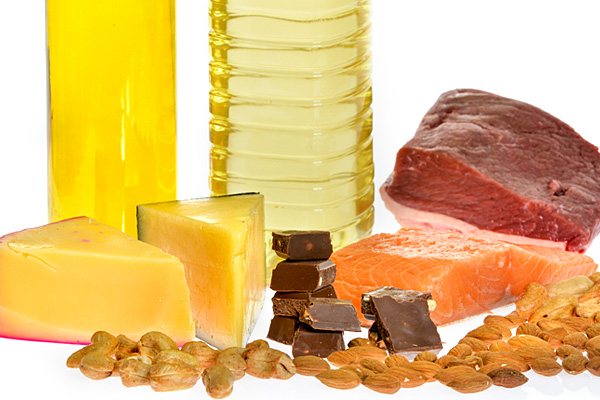
Many people believe that the body does not need fats at all, and when creating a menu for a teenager, it is better to do without them altogether. However, this is fundamentally wrong. Fat is also an important source of energy. In addition, cholesterol, hated by many, is part of sex hormones and adrenal hormones.
Of course, excessive consumption of fat is harmful to the body. It can lead to the development of atherosclerosis and obesity. And this is the background for the development of many cardiovascular (coronary heart disease, hypertension) and endocrine diseases (diabetes mellitus).
The optimal solution is to give preference to vegetable fats over animal fats. They are found in corn and sunflower oil, fish oil. It is interesting that sunflower and other vegetable oils have benefits for the body only in their primary form (for example, in salads), while they are of no value when fried or baked.
What products should be removed from the menu?
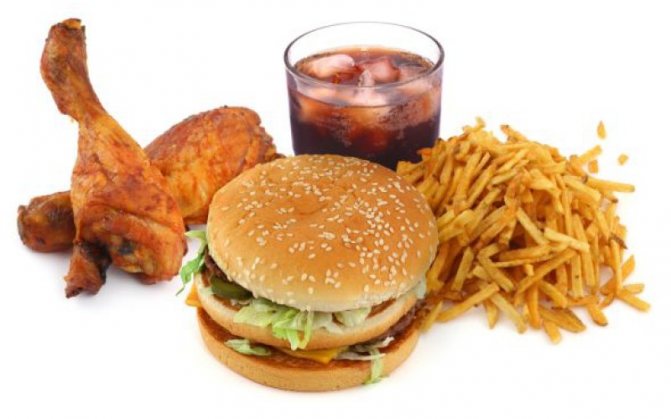
To create a truly balanced menu for a teenager, you need to highlight a list of dishes and products that are not recommended or even prohibited for consumption. Products containing excessive amounts of animal fats and easily digestible carbohydrates should be excluded from the diet.
Such favorite foods of teenagers as all kinds of sandwiches and burgers, french fries, chips and other snacks can be called “forbidden foods.” After all, they contain a large amount of cholesterol, which is deposited on the walls of blood vessels, causing poor circulation in the internal organs.
It will also be difficult for those with a sweet tooth. After all, flour and bakery products, chocolates should be limited as much as possible when creating a menu for a teenager. Only eating one or two sweets per day or one bun is allowed. And for teenagers who are overweight, these products should be completely removed from the diet. It is better to replace them with fruits for a teenager. You and I already know the dangers of eating simple carbohydrates.
Among drinks when creating a menu for a teenager, preference should be given to plain water. For variety, you can also quench your thirst with freshly squeezed juices. Factory juices and carbonated drinks contain large amounts of sugar.
What liquids should I give?
Teenagers have long known what coffee, tea, and carbonated drinks are. Many people prefer to play adults and allow themselves to drink harmful drinks. But sweet soda, for example, leads to extra pounds, skin problems, causing acne, and negatively affects the functioning of the digestive system.
Juices sold in stores are not much healthier than soda. Children are accustomed to such juices literally from the cradle, producing small packages of this drink for children from 6 months. Growing up, they find it natural to drink food this way. You need to explain to your child that the main preservative in this product is sugar, of which too much is added. If a teenager loves juices, it is better to purchase a juicer and prepare them at home, from fresh fruits and vegetables. Most teenagers today strive for a healthy lifestyle and you can find many recipes for healthy fruit smoothies on the Internet.
The ideal drink is ordinary water. You can buy bottled mineral water without gas, or you can simply use a filter or boil tap water. It contains no additives that are harmful to the growing body, no dyes. The norm for drinking liquid is up to 2.5 liters per day. It does not include teas, soups, dairy products and other liquids that many consider drinking.
Teen diet rules
Before moving on to dietary examples, it is worthwhile to look at the general rules that must be followed when providing proper nutrition for a teenager. In addition to the recommendations that have already been indicated in the previous sections of the article, it is also worth noting the following rules:
- Eat small portions, leaving a slight feeling of hunger when eating. After all, the feeling of fullness does not come immediately after eating; time must pass for impulses from the stomach receptors to reach the hunger center in the hypothalamus and inform it that food has arrived. This “delay” often leads to situations where the teenager eats too much.
- The main meal should be in the first half of the day. Many people are accustomed to eating a small portion of breakfast or not having breakfast at all, but to gorge themselves in the evening, after coming home from school. However, this is fundamentally wrong. The peak activity of digestion occurs in the morning, so food is best absorbed at this time.
- The last meal should be at least 2 hours before bedtime. Many people know about the “don’t eat after 6” rule, but it’s not entirely logical. If a teenager goes to bed at 20:00, then, of course, this rule is true for him. However, does anyone know a teenager who goes to bed at 8:00 pm? So, if he goes to bed at 24:00, it is quite acceptable to eat at 22:00. But again, it’s worth remembering that you shouldn’t overeat.
- The most optimal way of cooking: stew, boil or bake.
How to teach your child to eat right

Teenagers often snack on the go and avoid family meals, which is bad for their health.
To encourage school-aged children to eat properly, you can use the following recommendations:
- If your child is a fan of any sport, then explain to him that a balanced diet will help him keep his body in great shape.
- Children aged 14-15 years often develop acne, their hair quickly becomes oily, which causes them complexes. Tell us that eating right will help you avoid this.
- Remind your teen that eating homemade food will save money.
- Always leave tasty, healthy food in the kitchen that your child likes.
- Invite him to join the family meal more often.
And most importantly, be an example for children. If they see that their parents eat right and look good, they will also strive for this (at least on a subconscious level).
The oldest myth about healthy eating

Soup is not a necessary dish in a healthy diet for a teenager! This phrase may surprise many. After all, we all remember how mom worried every day whether we had eaten soup today. Yes, this is a really good dish. Boiled meat, vegetables, liquid. However, you can just as easily eat a salad and wash it down with a glass of cold water. Moreover, soups are also different. There is nothing healthy at all in those rich, fatty soups that our grandmothers love to cook. Therefore, if your child likes soup and eats it with pleasure, it’s good for him, but if not, you shouldn’t force him.
What a teenager from 11 to 17 years old needs to know about diet
Content:
- What a teenager from 11 to 17 years old needs to know about diet
- What foods are recommended to be removed from a teenager's diet?
- Rules for teenage diet for weight loss
- Diet options for teenagers
- General recommendations
All metabolic processes in a growing body occur somewhat differently compared to an adult body, therefore, if there are no medical indications for losing weight (diabetes, heart failure, etc.), you should not starve yourself with diets.
It is very important for teenagers, starting from 11 years old and up to 17 years old, to provide their body with all the necessary microelements and vitamins. If you remove all the necessary components for the full development of the body, then in five to ten years you will experience problems with both weight and health. Most often, the problem with extra pounds in adolescence disappears by the time the body fully matures.
Teenage diets at 11, 12, 13 years old and up to 17 years old can cause problems: with hormonal levels, skin condition, hair and nails. It is important to understand that a teenage diet is not starvation, it is a properly selected healthy diet without fast food, sweets and other junk food.
To get more results from a healthy diet, it is important to combine it with light physical activity - running, swimming, frequent walks in the park, rollerblading and cycling. The main thing for a teenage diet is to regularly eat healthy and nutritious foods.
Cottage cheese casserole with pumpkin and dried apricots
Who doesn't love cottage cheese casserole? Many housewives know its recipe from their mothers and grandmothers. However, let's diversify this healthy recipe a little by adding pumpkin and dried fruits. The best combination with pumpkin is dried apricots. Casserole is the perfect option for a light and healthy dinner.
What we need for cooking:
- pumpkin - 200 g;
- cottage cheese - 300 g;
- eggs - 2 pcs.;
- dried apricots - 50 g;
- sour cream - 2 tbsp;
- water – 0.5 cups (100 ml),
- sugar - to taste, 2-3 tbsp. l. (if the child does not have a big sweet tooth, you can limit yourself to 1 tablespoon).
Cooking steps:
- Cut the pumpkin pulp into cubes and simmer in a thick-bottomed saucepan until soft.
- Mix cottage cheese with sour cream and beat thoroughly until smooth. Add dried apricots (pre-finely chopped), eggs and sugar to the mixture. Mix.
- When the pumpkin is cooked, you need to mash it to a puree-like consistency. Once cooled, add to the curd mixture.
- Distribute the cottage cheese-pumpkin mixture evenly in a buttered baking dish. Place in the oven at 180 degrees. Baking duration: 30 minutes (until a golden crust appears on the dish).
Weight and height standards for teenagers 14–16 years old
| Age | Girls | Boys | ||
| Height/cm | Weight, kg | Height/cm | Weight, kg | |
| 14 years | 155,4–163,6 | 48,2–58,0 | 156,2–167,7 | 42,8–56,6 |
| 15 years | 157,2–166,0 | 50,6–60,4 | 162,5–173,5 | 48,3–62,8 |
| 16 years | 158,0–166,8 | 51,8–61,3 | 166,8–177,8 | 54,0–69,6 |
Baked fish with vegetables
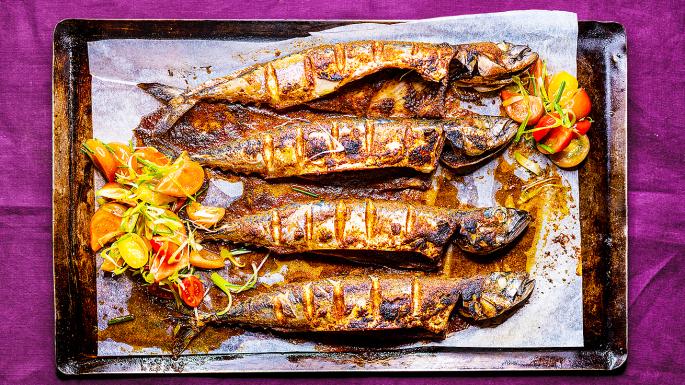
Unfortunately, it is often quite difficult to get teenagers to eat fish. However, it is a truly necessary product in the diet, being the main source of phosphorus. Below is a recipe for a delicious fish dish for a teenager.
What we need for cooking:
- sea fish (ideally mackerel or pink salmon);
- hard cheese – 100 g (salted farm cheeses are considered the healthiest, as they do not contain vegetable fats);
- carrots – 1 pc.;
- onion – 1 pc.;
- lemon - several slices.
Cooking steps:
- Clean the fish thoroughly and cut off the head. Rub the cleaned carcass with salt.
- Chop the onion, grate the carrots and cheese, mix and add salt to taste.
- Cut the fish lengthwise from one edge, but not completely, but so that the second edge remains unaffected. Stuff the fish with vegetables and cheese. Also place lemon slices inside; they will soak the filling and fish so that it does not dry out in the oven.
- Wrap the dish in foil and place in an oven preheated to 220 degrees for 40 minutes.
When and how much?
Ideally, a teenager should eat four times a day
, but not all children want to follow such a regime.
The parents' task is to ensure that food is taken on time. A teenager's breakfast should provide 25 percent of daily energy needs, lunch - 35-40 percent, afternoon snack - 15, and dinner - 20-25 percent. Breakfast, lunch and dinner must be hot
. In addition, it is advisable that the teenager eat at least three servings of dairy products per day, including milk porridge or cottage cheese casserole. And fresh vegetables or fruits should be included in every meal and become an independent snack - instead of chips or candy.
Boiled sausage
What teenager doesn't like sausage sandwiches? It is quite difficult to wean children off it, because manufacturers add a lot of addictive flavor enhancers to the sausage. An excellent substitute for store-bought sausage can be homemade boiled sausage, a healthy recipe for which is outlined below.
What we need for cooking:
- chicken or turkey fillet – 0.5 kg;
- chicken egg white – 3 pcs.;
- sour cream – 250 ml;
- salt and pepper to taste.
Cooking steps:
Grind the fillet using a blender to a paste consistency. Add egg whites and sour cream to the chicken pasta, salt and pepper. Stir.
The minced meat must be divided into four equal parts, each placed separately on cling film. Roll them into sausage shapes so that the film wraps them in at least three layers. The ends of the film must be tied with threads on both sides. These manipulations are necessary to prevent the mixture from spreading throughout the pan during further cooking.
Boil water in a saucepan. When the water boils, place the sausages there for 40 minutes. Place the sausages on a plate and let cool. Homemade boiled sausage is ready to eat!
Salads for teenagers

Few children and teenagers like salads, or vegetables in general. Fortunately, salad is a dish that gives free rein to imagination and improvisation.
If your child loves chicken, you can make a Caesar. If you have beef or pork, you can prepare a warm meat salad. Or you can move away from any recipes. For example, an ordinary vegetable salad can be diluted with a bright berry sauce, which a teenager will surely like. Vegetables also go well with applesauce and mustard sauce. Improvise, come up with new tastes, then your child will definitely discover salads from a new side.
How to create a healthy menu for every day with calorie calculations: recommendations for the week
When you plan your child's diet, take into account his daily routine.
The principles of creating a weekly menu with proper nutrition are simple. An approximate diet for each day can be oriented according to the table:
| Breakfast | Main course – 300 g, drink – 200 ml. Options: porridge with milk, cottage cheese or dishes made from it, omelet. You can supplement this food with vegetables, fresh or dry fruits, lean meat, and homemade sauce. |
| Dinner | 250 mg liquid food, 100 g vegetable salad, 300 g main dish, 200 ml drink. |
| Afternoon snack | Fermented milk products, fruits, cookies. The serving size is 100 g, you can wash it all down with 200 ml of drink. |
| Dinner | Main course – 300 g and 200 ml of drink. Examples of food: cottage cheese baked goods, egg or fish dishes, porridge with vegetables. |
Bread can be consumed during every meal. It is better to give preference to a whole grain product.
Important! The correct diet for a teenager should be based on calories. The daily calorie menu for girls is 2500 kcal, and for boys - 3000 kcal. Within 24 hours, children should consume 30% fat, 20% protein, 50% carbohydrates.


